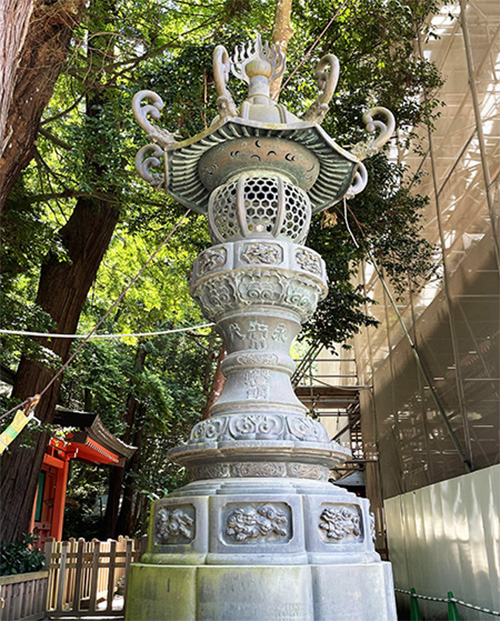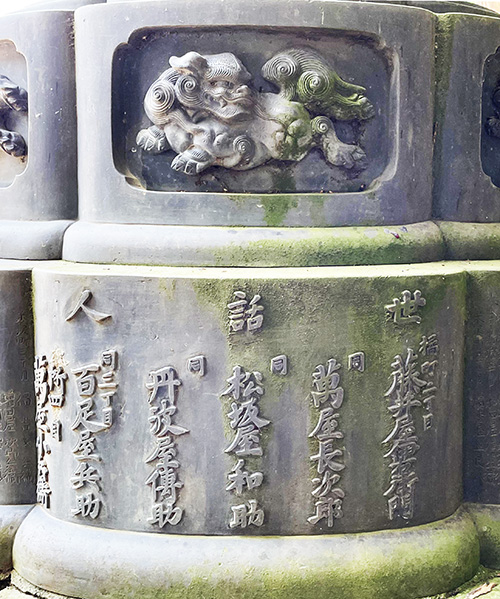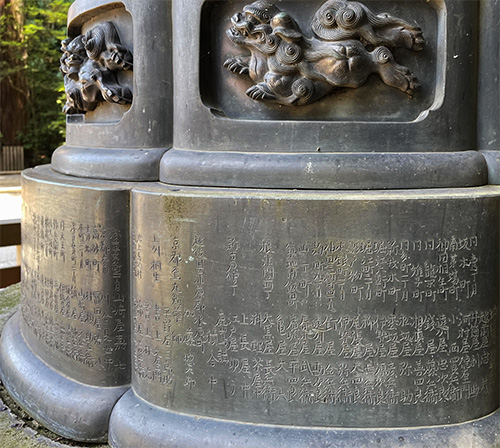
連載ブログのきっかけだったSuica紛失、地元警察からの発見のお知らせと再発行手続きの全プロセスは無事に完了して、残額6,500円ほどのカードはいまわたしの財布に仕舞い込まれています。
鹿島神宮への尊崇のこころは歴世の人びとが共有してきたモノでしょうが、わたし自身も前述の経緯から、多くの人びとの善意の積層に深く感謝しております。
そんなことで最後にちょっと驚かされていた鹿島神宮本殿脇の「石灯籠」について。
写真のような本体のお姿なのですが、素性のわかるような記録とかはWEB上でも、どうしても見つかりません。しかし、石を加工してここまでの装飾性を実現させるのは驚異的。まぁわたしもいつも目をこらして石灯籠を注視してきた経験はないのですが、ふとこの石灯籠を見て、思わず、シャッターを切っていた次第なのです。
頂部の傘の部分には端部に飾りが付けられて反り返っている。その下の灯明部にはステンドグラス並みのこまかな格子枠が端正に刻印されている。その下の胴体部には多様な紋様、たぶん十二支を意識したのではと想像できる彫刻模様が美しく刻印されている。
外部からは、灯明部に火を点けるにはどうするのか不明でしたが、その造形の巧みさには、そしてその本体が石であることを重ね合わせると、江戸期と思われる工芸技術のレベルの高さを強く印象づけられる。


台座の下には、たぶん寄進者とおぼしき名前がズラッと記載されている。
「世話人」とあるので、たぶん鹿島神宮への篤い信仰心を持った人びとが浄財を集めて石工の名人に制作を依頼して、鹿島神宮にお願いして奉納されたものでしょう。はるかな昔人のみなさんの篤志の高さに、令和の現代、その神徳で救済されたひとりとして、まことに頭の垂れる思い。
世話人には「橘(?)町二丁目」と住所の記載がある。橘町とすれば江戸時代の日本橋周辺にこの町名がある。そして藤井屋とか、萬屋、松坂屋、丹波屋、百足屋などの屋号が見えているので、これらの商人たちが連名で行った寄進行為ではないかと想像できる。
続いてもうちょっと寄進額が少額だったと推定できる名簿記載からも、遠州屋とか、相模屋、さらには「銭屋」などの商号屋号が記されている。ここにも「神田相生町」というような地名も記されていることから、やはり江戸の商家たちが寄進したものと推定されるのですね。
江戸から鹿島までは現在でも92.6kmで徒歩であれば19時間以上の距離。江戸時代のふつうの感覚で考えると、3-4日の移動距離。往復と考えると1週間程度の距離感ですが、神田の商店主たちの信仰心、鹿島信仰はそれほどに強かったという証拠なのでしょうか。
工作の精妙さに加えて、江戸期の庶民に鹿島さんがどれほどの存在であったか、物証としてあきらかだと思えた次第です。
English version⬇
Artistic Stone Lanterns and Donors: Exploration of Three Shrines in Eastern Japan-7
The exquisiteness of the stoneworking techniques of the Edo period and the high esteem in which Edo merchants held the Kashima Jingu Shrine are truly evident. …
The Suica card that triggered this series of blogs was lost, and after the local police notified me of its discovery and the entire process of reissuing the card was successfully completed, the remaining 6,500 yen is now tucked away in my wallet.
I am deeply grateful to the many people who have laminated their goodwill to the Kashima Jingu Shrine, and I am sure that the spirit of reverence for the shrine has been shared by people throughout the ages.
Lastly, I would like to talk about the “stone lantern” by the main shrine of Kashima Jingu Shrine, which surprised me a little.
The main body of the lantern is as shown in the photo, but I cannot find any record of its identity on the web. However, it is amazing that the stone is processed to achieve such a high level of decorativeness. Well, I have not always had the experience of looking closely at stone lanterns, but when I suddenly saw this stone lantern, I couldn’t help but click the shutter.
The umbrella at the top is warped with decorations at the ends. Below that, the lantern has a finely engraved latticework frame as intricate as stained glass. Below that, the body is beautifully engraved with a variety of patterns and carvings that may have been inspired by the twelve signs of the Chinese zodiac.
From the outside, it was unclear how to light the lantern section, but the skillfulness of the modeling, combined with the fact that the body is made of stone, strongly impresses us with the high level of craftsmanship that seems to have been used during the Edo period.
Underneath the pedestal is a list of names of donors.
Since the name of the donor is “Caretaker,” it was probably made by people with a deep religious faith in Kashima Shrine, who collected money and asked a master stonemason to create it, and then asked Kashima Shrine to dedicate it. As one of those who have been saved by the divine virtues of these people in this day and age of 2025, I am truly humbled by the high level of devotion of these people from long ago.
The sponsor was listed as “Tachibana (?) Machi 2-chome. The address of the caretaker is written as “Tachibana (?) town 2-chome. Tachibana-cho is the name of a town in the Nihonbashi area during the Edo period. And since we can see store names such as Fujii-ya, Banya, Matsuzakaya, Tambaya, and Hyakusokuya, we can imagine that the donation was made by these merchants in joint names.
The next item on the list, in which the amount of donation is estimated to have been a little smaller, also shows shop names such as “Enshuya,” “Sagamiya,” and even “Senya. The fact that the name of the place “Kanda Aioi-cho” is also written here suggests that the donation was made by merchant families in Edo.
Even today, the distance from Edo to Kashima is 92.6 km, which would take more than 19 hours on foot. In the normal sense of the Edo period, it would take 3 to 4 days to travel this distance. If we consider it as a round trip, the distance would be about one week.
In addition to the exquisiteness of the craftsmanship, it is clear evidence of how much Kashima-san was known to the common people of the Edo period.
Posted on 8月 11th, 2023 by 三木 奎吾
Filed under: 日本社会・文化研究







コメントを投稿
「※誹謗中傷や、悪意のある書き込み、営利目的などのコメントを防ぐために、投稿された全てのコメントは一時的に保留されますのでご了承ください。」
You must be logged in to post a comment.